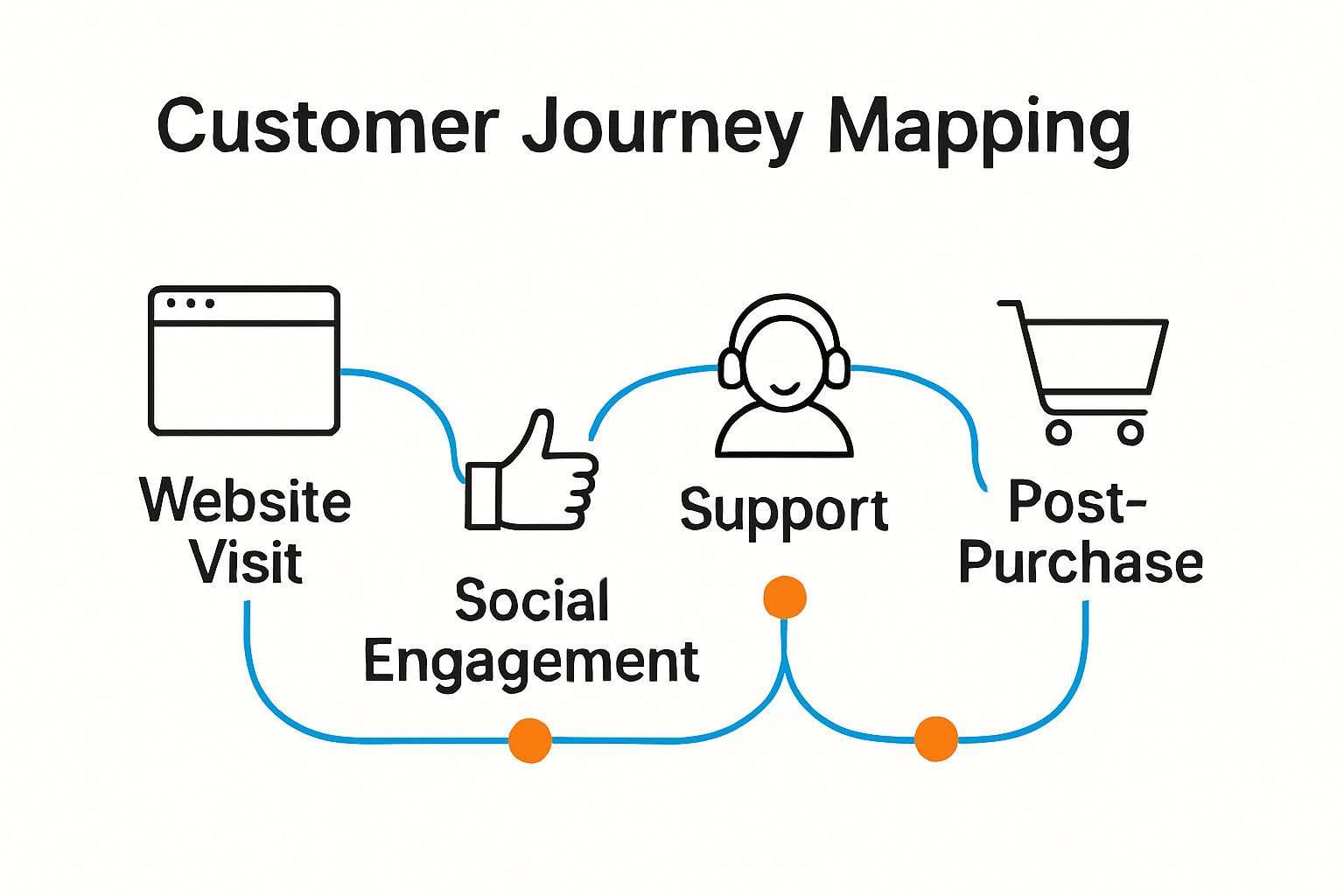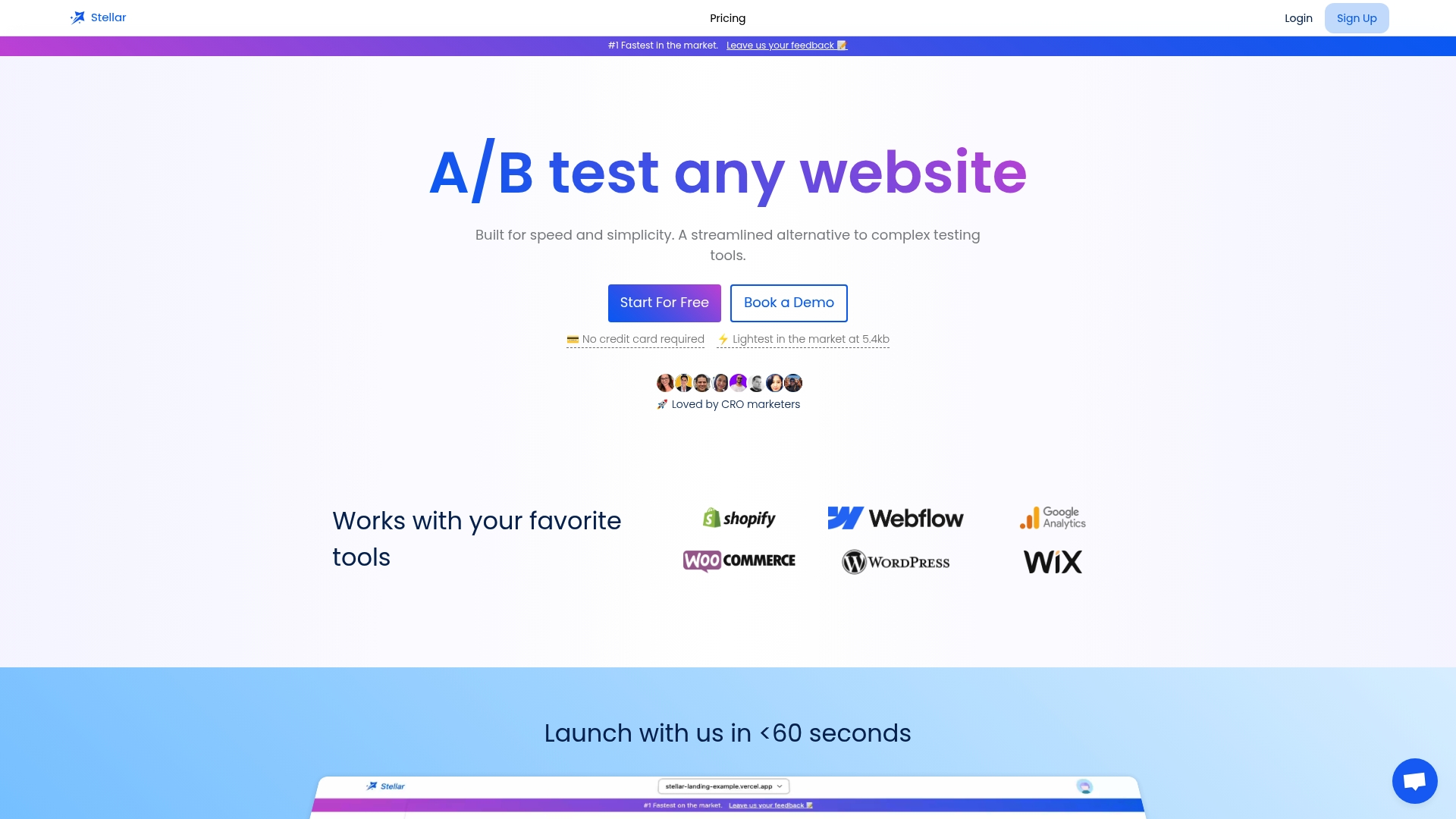
Customer Journey Mapping for CRO Marketers in 2025

Customer journey mapping is now a secret weapon for brands serious about growth. Here is a surprise. Detailed journey mapping can boost customer experience metrics by up to 25 percent and drive revenue up by as much as 15 percent. Yet most companies are still missing the real opportunity—not just drawing pretty diagrams, but turning every interaction into real-world results that keep customers coming back.
Table of Contents
- Why Customer Journey Mapping Matters For Growth
- Steps To Build Effective Customer Journey Maps
- Proven Strategies To Optimize Each Journey Stage
- Customer Journey Mapping Tools And Real-World Examples
Quick Summary
| Takeaway | Explanation |
|---|---|
| Customer Journey Mapping Enhances Growth | Detailed mapping can improve customer experience metrics by up to 25% and significantly boost conversion rates, driving revenue growth of 10-15%. |
| Utilize Comprehensive Research Strategies | Effective journey maps are built on both qualitative and quantitative data, using methods like customer surveys and analytics reviews to understand customer behavior. |
| Iterate Regularly on Mapping Processes | Treat customer journey maps as living documents, incorporating ongoing stakeholder feedback and regularly refreshing data to keep up with changing customer expectations. |
| Optimize Each Journey Stage | Implement tailored strategies across the awareness, conversion, and retention stages to enhance customer engagement and foster loyalty. |
| Leverage Advanced Mapping Technologies | Utilize tools with features like real-time analytics and predictive modeling to create dynamic visualizations and insights that enhance customer interaction understanding. |
Why Customer Journey Mapping Matters for Growth
 Customer journey mapping represents a critical strategic approach for businesses seeking sustainable growth in an increasingly complex digital marketplace. By providing a comprehensive visual representation of customer interactions, this methodology enables organizations to understand and optimize the entire customer experience from initial awareness to long term loyalty.
Customer journey mapping represents a critical strategic approach for businesses seeking sustainable growth in an increasingly complex digital marketplace. By providing a comprehensive visual representation of customer interactions, this methodology enables organizations to understand and optimize the entire customer experience from initial awareness to long term loyalty.
Understanding Customer Experience Touchpoints
Customer journey mapping goes beyond traditional marketing analytics by creating a holistic view of how customers interact with a brand. According to research from Harvard Business Review, organizations that implement detailed customer journey maps can improve customer experience metrics by up to 25% and increase conversion rates significantly.
The process involves systematically tracking every interaction a customer has with a brand. These touchpoints might include website visits, social media engagement, customer support interactions, product purchases, and post purchase experiences. By meticulously documenting each step, businesses can identify potential friction points and opportunities for optimization.

Driving Strategic Business Growth
Customer journey mapping is not just a visualization exercise but a powerful strategic tool for driving business growth. Research from McKinsey reveals that companies with robust customer journey mapping strategies experience 10-15% revenue growth and significant improvements in customer retention rates.
Key benefits of comprehensive customer journey mapping include:
- Personalization Opportunities: Detailed mapping allows businesses to create highly targeted marketing strategies.
- Pain Point Identification: Businesses can proactively address customer challenges before they become significant issues.
- Resource Allocation: Understanding customer interactions helps optimize marketing and support investments.
Data Driven Decision Making
Modern customer journey mapping leverages advanced analytics and machine learning technologies to provide deeper insights. A study by Forrester Research indicates that data driven journey mapping can help businesses predict customer behavior with 85% accuracy, enabling more strategic and proactive engagement approaches.
By transforming raw customer interaction data into actionable insights, organizations can make informed decisions that directly impact growth. This approach moves beyond traditional reactive strategies, allowing businesses to anticipate customer needs and create more meaningful, personalized experiences.
Customer journey mapping represents a fundamental shift in how businesses understand and engage with their customers. It transforms complex interaction data into a clear, strategic roadmap for growth, enabling organizations to build more responsive, customer centric strategies that drive long term success.
Steps to Build Effective Customer Journey Maps
Creating effective customer journey maps requires a strategic and systematic approach that goes beyond simple data collection. Successful mapping demands a nuanced understanding of customer experiences, motivations, and potential interaction points across multiple channels.
Defining Comprehensive Research Strategies
According to Adobe's Business Insights, developing an impactful customer journey map begins with comprehensive research methodologies. Organizations must collect both qualitative and quantitative data to create an accurate representation of customer interactions.
Key research techniques include:
- Customer Surveys: Direct feedback mechanisms that capture authentic user experiences
- User Testing: Observational studies revealing actual customer behavior patterns
- Analytics Review: Examining digital interaction data to understand navigation and engagement
These research methods provide multidimensional insights into customer behaviors, revealing not just what customers do but understanding the underlying motivations driving their actions.
To better visualize the core research techniques discussed above, the table below summarizes each method's nature and what insight it provides:
| Research Technique | Description | Key Insights Gained |
|---|---|---|
| Customer Surveys | Collects direct user feedback through questionnaires | Authentic experiences, satisfaction |
| User Testing | Observational studies on real user interactions | Actual behavior, usability issues |
| Analytics Review | Quantitative review of digital engagement data | Navigation flow, engagement metrics |
Mapping Touchpoint Interactions
Research from Gartner emphasizes the critical importance of identifying and analyzing every potential customer touchpoint. This involves creating a detailed framework that captures interactions across digital and physical channels.
Effective touchpoint mapping requires marketers to consider:
- Website interactions
- Social media engagement
- Email communications
- Customer support channels
- Physical store experiences
- Mobile application interactions
By meticulously documenting each interaction point, businesses can uncover potential friction areas and opportunities for optimization.
Implementing Iterative Mapping Processes
According to Nielsen Norman Group, customer journey mapping is not a one time exercise but an ongoing iterative process. Successful organizations treat their journey maps as living documents that evolve with changing customer expectations and technological advancements.
Key implementation strategies include:
- Regular data refreshment
- Continuous stakeholder feedback integration
- Periodic performance metric analysis
- Cross functional collaboration
The most effective customer journey maps transcend simple documentation. They become strategic tools that align organizational efforts with customer expectations, driving meaningful improvements in overall experience design and customer satisfaction.
By adopting a holistic, research driven approach to customer journey mapping, businesses can transform complex interaction data into actionable insights that fuel sustainable growth and competitive advantage.
Proven Strategies to Optimize Each Journey Stage

Optimizing the customer journey requires a strategic approach that addresses each stage of customer interaction with precision and thoughtfulness. By implementing targeted strategies, businesses can create a seamless and engaging experience that guides customers from initial awareness to long term loyalty.
Below is a summary table that organizes the key optimization strategies for each stage of the customer journey, helping marketers scan and apply best practices across stages:
| Journey Stage | Key Strategies | Benefits/Goals |
|---|---|---|
| Awareness & Attraction | Personalized content, multi-channel, SEO | Capture attention, increase engagement |
| Conversion & Consideration | Streamlined UX, AI recommendations, trust signals | Improve conversion rates, reduce friction |
| Retention & Loyalty | Personalized programs, continuous value, feedback | Foster loyalty, drive repeat interactions |
Awareness and Attraction Stage
Research from McKinsey highlights the critical importance of the initial customer touchpoints. At the awareness stage, businesses must create compelling content and targeted marketing approaches that capture potential customer attention.
Key strategies for optimizing the awareness stage include:
- Personalized Content Marketing: Develop highly targeted content that addresses specific customer pain points
- Multi Channel Engagement: Utilize diverse platforms to reach potential customers
- Search Engine Optimization: Ensure visibility across digital search platforms
Companies that effectively optimize their awareness stage can significantly improve initial customer engagement and reduce customer acquisition costs.
Conversion and Consideration Stage
According to Adobe's Business Insights, the conversion stage represents a critical moment where potential customers decide whether to engage with a brand. Research from ResearchGate suggests that AI enhanced tools can improve conversion rates by up to 12% by providing more personalized and responsive interaction experiences.
Effective optimization strategies for this stage include:
- Streamlined User Experience: Reduce friction in the conversion process
- Personalization Technologies: Implement AI driven recommendation systems
- Trust Building Elements: Integrate social proof and transparent communication
Retention and Loyalty Stage
A study by Nielsen Norman Group emphasizes that customer retention is often more cost effective than acquisition. The final stage of the customer journey focuses on creating lasting relationships and encouraging repeat interactions.
Proven retention strategies include:
- Personalized Engagement Programs: Create tailored communication and offers
- Continuous Value Delivery: Consistently provide exceptional customer experiences
- Feedback Loop Integration: Actively incorporate customer insights into product development
By implementing a comprehensive approach that addresses each stage of the customer journey, businesses can create a more responsive and customer centric experience. The key lies in understanding customer needs, leveraging advanced technologies, and maintaining a flexible approach that adapts to changing customer expectations.
Successful customer journey optimization is not about implementing a one size fits all solution but about creating a dynamic, responsive strategy that evolves with customer preferences and technological advancements.
Customer Journey Mapping Tools and Real-World Examples
Customer journey mapping has evolved from a theoretical concept to a practical business strategy, supported by sophisticated tools and inspiring real world implementations. Understanding the landscape of available technologies and successful case studies can provide valuable insights for organizations seeking to enhance their customer experience strategies.
Advanced Customer Journey Mapping Technologies
Gartner Research reveals that modern customer journey mapping tools leverage artificial intelligence and machine learning to provide unprecedented insights into customer behaviors. These sophisticated platforms enable businesses to create dynamic, data driven visualizations of customer interactions.
Key technological features include:
- Real Time Analytics: Tracking customer interactions across multiple channels
- Predictive Modeling: Forecasting potential customer behaviors
- Automated Segmentation: Identifying distinct customer personas automatically
Innovative Industry Implementation Examples
According to Adobe's Digital Experience Report, several leading companies have transformed their business strategies through strategic customer journey mapping:
- Spotify: Revolutionized music recommendation systems by mapping user listening patterns and preferences
- Amazon: Developed hyper personalized shopping experiences through comprehensive journey tracking
- Netflix: Created sophisticated content recommendation algorithms based on detailed user interaction maps
Research from Forrester indicates that companies implementing advanced journey mapping technologies can improve customer satisfaction rates by up to 35% and reduce customer acquisition costs by 20%.
To highlight how different brands have benefited from customer journey mapping, the summary table below showcases the impact for each:
| Company | Implementation Focus | Impact/Results |
|---|---|---|
| Spotify | User listening pattern mapping, recommendations | Superior personalization in music curation |
| Amazon | Personalized shopping journeys | Hyper-targeted offers, higher conversion & loyalty |
| Netflix | Content recommendation via user interaction | Increased engagement, longer retention |
Selecting the Right Mapping Tools
According to UserTesting.com, choosing the right customer journey mapping tool depends on several critical factors:
- Organizational Size: Different tools suit various business scales
- Integration Capabilities: Compatibility with existing technology infrastructure
- Budget Constraints: Range of tools from free to enterprise level solutions
Top recommended tools include:
- Smaply: Ideal for detailed visual journey mapping
- UXPressia: Strong in collaborative mapping features
- Lucidchart: Excellent for cross functional team engagement
Successful customer journey mapping goes beyond technological implementation. It requires a holistic approach that combines advanced tools with deep human insights, creating a comprehensive understanding of customer experiences across all interaction points.
As technologies continue to evolve, customer journey mapping will become increasingly sophisticated, enabling businesses to create more personalized, responsive, and engaging customer experiences that drive long term growth and customer loyalty.
Frequently Asked Questions
What is customer journey mapping?
Customer journey mapping is a strategic approach that visualizes the interactions and experiences a customer has with a brand throughout their lifecycle. It helps businesses understand customer behaviors, motivations, and potential friction points.
Why is customer journey mapping important for growth?
Customer journey mapping is essential for growth because it can enhance customer experience metrics by up to 25% and increase revenue by 10-15%. It allows businesses to identify pain points and opportunities for personalization, ultimately driving customer satisfaction and loyalty.
How do I create an effective customer journey map?
To create an effective customer journey map, start by defining comprehensive research strategies that include customer surveys, user testing, and analytics reviews to gather both qualitative and quantitative insights. Then, map out touchpoint interactions and treat the mapping process as iterative, updating it regularly based on stakeholder feedback and changing customer expectations.
What tools can I use for customer journey mapping?
There are several tools available for customer journey mapping, including Smaply for detailed visual maps, UXPressia for collaborative features, and Lucidchart for cross-functional team engagement. Choose a tool based on your organization's size, integration capabilities, and budget constraints.
Ready to Bring Your Customer Journey Maps to Life?
Are you struggling to turn detailed customer journey insights into real growth? This article outlined how understanding every interaction—then optimizing those touchpoints—can increase revenue and boost customer loyalty. But the biggest barrier for many CRO marketers is actually implementing those data-driven changes without slowing down their sites or needing a developer for every optimization. If this sounds familiar, you are not alone. Many marketers find that the real challenge is moving from journey diagrams to fast, effective testing that directly improves conversion rates.

Why wait to see if your ideas work? Stellar is the fastest and easiest way to experiment on your website using real-time analytics and instant A/B tests with a lightweight script. Use the no-code visual editor to quickly adjust touchpoints across your entire funnel. Take your customer journey maps from theory to action, see what works today, and drive more growth without technical bottlenecks. Visit gostellar.app and start optimizing your best ideas in minutes. The journey to higher conversions begins right now.
Recommended
Published: 7/16/2025